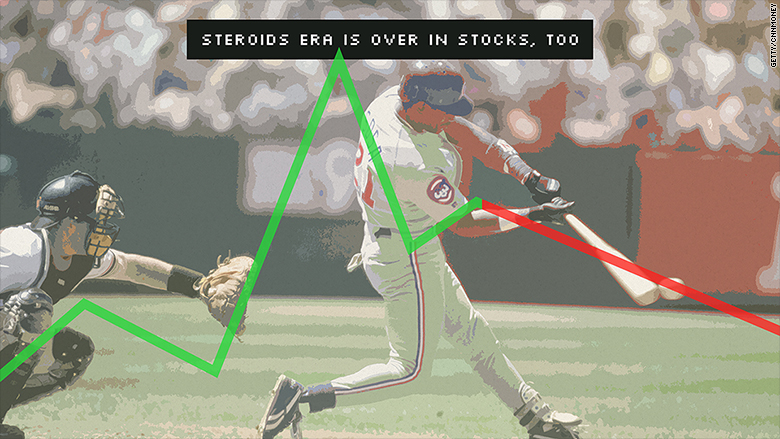
During baseball's steroids era, it seemed like home run records were broken all the time. That's what the bull market in stocks has felt like the past few years.
The S&P 500 celebrated an incredible 98 record closing highs during 2013 and 2014, according to S&P Dow Jones Indices. And last week, the Nasdaq notched a closing high last seen in March 2000.
But Wall Street records may soon be harder to come by as the Fed-induced "steroids" are taken away.
The extremely low interest rates and quantitative easing provided by the Federal Reserve made stocks look very attractive. QE ended last year and interest rates look like they'll start climbing higher later this year.
What's more, the U.S. economy stumbled at the end of 2014 and the beginning of 2015. That's dented corporate profits and hurt stocks.
"It's harder to hit home runs in October because it's colder and the air is heavier. This is clearly not the midsummer for the stock market rally," said David Kelly, chief global strategist at JPMorgan Funds.
Related: Finally! Nasdaq tops its March 2000 record
Watching the Fed: Whether the rate hike comes in June, September or later, it's coming. The Fed wraps up a two-day meeting on Wednesday, when it's expected to acknowledge the recent slowdown in the U.S. economy and signal that interest rates could rise later this year.
That's forcing investors to take a more sober look at stocks -- and some don't like what they see.
"We remain less bullish and less convinced in the sustainability (of the rally) in front of a looming change in monetary policy," Dan Greenhaus, chief global strategist at BTIG, wrote in a research note.
Related: Junk food's back! And 4 other things we learned from earnings
Strong corporate earnings need to come back: Earnings growth ground to a near halt during the fourth quarter due to the economic slowdown, stronger U.S. dollar and depressed oil prices.
That in turn has made stocks look like less of a good deal. The S&P 500's forward price-to-earnings ratio stands at about 17.5, according to S&P Capital IQ. That's not astronomically high, but it's not a price you'd find at Wal-Mart (WMT)either.
"Stocks still look better than bonds, but it's very tough to say stocks look cheap," said Russ Koesterich, chief investment strategist at BlackRock.
Future gains in the stock market will need to be driven by earnings growth, Koesterich said.
And for companies to ramp up earnings growth, they will need to generate stronger revenue.
That requires the economy to bounce back from a bleak first quarter. Investors will get a glimpse of where the U.S. economy stands on Wednesday, when the government releases its first look at gross domestic product.
U.S. may lag behind: While waiting for the U.S. economy to resume growth, international equities could continue to outperform.
Where? Koesterich is advising clients to check out stocks in fast-growing India, resurgent Europe, and Japan, where stocks hit a 15-year high last week.
Of course, none of this means people should dump U.S. stocks. Despite a potential Fed rate hike, more records are likely to come, just at a slower pace than earlier in the bull market.
"It would be highly unusual for an initial rate hike to lead to a bear market," said Koesterich.


